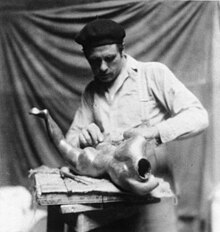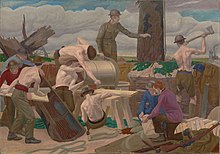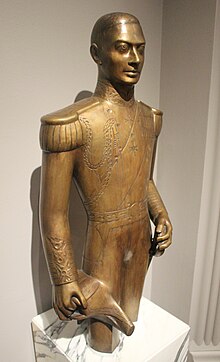Leon Underwood
Leon Underwood | |
|---|---|
 Underwood in his Hammersmith studio, ca 1930 | |
| Born | George Claude Leon Underwood 25 December 1890 Shepherd's Bush,London |
| Died | 9 October 1975(aged 84) London |
| Nationality | British |
| Education | |
| Known for | Sculpture, Wood-engraving |
| Spouse | Mary Coleman (m.1917) |
George Claude Leon Underwood(25 December 1890 – 9 October 1975) was a British artist, although primarily known as a sculptor, printmaker and painter, he was also an influential teacher and promotor of African art.[1][2]His travels in Mexico and West Africa had a substantial influence on his art, particularly on the representation of the human figure in his sculptures and paintings.[3]Underwood is best known for his sculptures cast in bronze, carvings in marble, stone and wood and his drawings. His lifetime's work includes a wide range of media and activities, with an expressive and technical mastery. Underwood did not hold modernism and abstraction in art in high regard and this led to critics often ignoring his work until the 1960s when he came to be viewed as an important figure in the development of modern sculpture in Britain.[4]
Biography
[edit]Early life
[edit]Underwood was born in the west London suburb ofShepherd's Bush.He was the eldest of the three sons of George Underwood, a fine art dealer and he attended Hampden Gurney School.[5][6]From 1907 to 1910 he attended theRegent Street Polytechnicin central London before studying at theRoyal College of Artfor three years.[7]While still a student in 1911, Underwood was commissioned to paint a mural for thePeace PalaceinThe Hague.[8]In 1913 he visited Russia to study the depiction of horses in traditional Russian art.[9]
World War I
[edit]
In theFirst World War,Underwood enlisted in theRoyal Horse Artillerybefore transferring to a field battery unit and then serving as a Captain in the Camouflage Section of theRoyal Engineers.[7][5]He worked withSolomon Joseph Solomonas a camoufleur, creating battlefield observation posts disguised as trees.[9][10]Underwood's duties on theWestern Frontincluded going intoNo man's landto make detailed drawings of trees which were later replaced with metal replicas used by military observers.[11]He sketched and painted scenes of this work, notably in his 1919 oil paintingErecting a Camouflage Tree,which was intended for the, never built, British nationalHall of Remembranceand was in turn purchased by theImperial War Museum.[10][12]
1920s and 1930s
[edit]After the war Underwood attended theSlade School of Artfor a year's refresher course and in 1920 received theBritish Prix de Romebut chose not to go to Italy, instead using the grant to travel elsewhere later in the decade.[7]He painted both formal portraits, such as that of the Canadian war hero G.B. McLean, andImpressionistworks such as the 1921 paintingVenus in Kensington Gardens.[13]In his Hammersmith studio Underwood set up a private art school, the Brook Green School, which he ran, intermittently, until 1938.[4]At Brook Green, Underwood initially, concentrated on teaching printmaking with woodcutting but also began making sculptures.[7][14]In 1925, with some of his past pupils, Underwood created the English Wood-Engraving Society to promote the art form.[14]Later in his career, between 1935 and 1945 Underwood created a significant number of colour linocuts.[14]
In 1922 Underwood had his first solo exhibition at theChenil Galleryin London.[7]An exhibition of his sculptures was held in 1924.[5]He also taught a life drawing class at theRoyal College of Artfrom 1920 until 1923 when he resigned and travelled to Paris and Iceland.[7]In 1925 he became the first contemporary artist to spend time examining the cave paintings atAltamirain Spain.[15]Underwood spent 1926 in the United States where he published an illustrated book of verse,Animalia,illustrated some volumes by others and also painted and made engravings.[3][16]InGreenwich Villagehe opened a life-drawing school.[17]In 1927 he went to Mexico, spending five months travelling and studyingAztecandMayanart forms.[3][14]

After returning to England in late 1928 Underwood made a number of paintings on Mexican themes, including imagined portraits ofMontezuma IIandHernán Cortés,the latter holding a stone heart in front of a ruined castle.[13]He also created several surrealist paintings, six of which were shown at the first, and only, exhibition of The Neo Society held at the Godfrey Phillips Gallery in London in May 1930.[18]With funding fromEileen Agar,Underwood co-founded a graphical quarterly magazine,The Island,in 1931 which, despite contributions fromHenry Moore,Agar,CRW NevinsonandMahatma Gandhiwas only published for four issues.[3][7][9][14][15][19]From 1932 to 1934, Underwood made a series of sculptures of dancing figures includingHerald of New Day,the plaster cast of which is now in theTatecollection.[20]In 1934 he published an artistic manifesto,Art for Heaven's Sake: Notes on a Philosophy of Art.[21]Underwood was always convinced that subject matter formed a fundamental role behind the power of both his own and primitive art, and had no belief in subject-less or purely abstract form in his own work. Underwood's 1935lignum vitaecarvingAfrican Madonna,orBlack Virgin,was inspired by aBantucarving and is sited inSt George's Cathedral, Cape Town.[22]
Underwood's 1937 bronze sculpture of KingGeorge VI,now in theNational Portrait Gallery, London,had originally been intended to be ofEdward VIIIbut was reworked after the abdication of December 1936. When first shown in public, theBuckingham Palaceauthorities asked that it be removed from view.[13]In 1938, Underwood closed the Brook Green School.[4]During the School's existence, its students had included Henry Moore, Eileen Agar,Gertrude Hermes,Blair Hughes-Stanton,Raymond Coxon,Edna GinesiandRoland Vivian Pitchforth.[9][18][19][23]Moore later spoke of his indebtedness to Underwood's teaching.[1][9]
World War II
[edit]From 1939 to 1942, duringWorld War II,Underwood worked at the civil defence camouflage centre atLeamington Spa.[7][5]In 1944, having long collected and studied non-Western art, he undertook a lecture tour, sponsored by theBritish Council,of west Africa and on his return to Britain wrote three books on aspects of African art.[3][9][23][21]These included a study of theIfeandBeninheads,Bronzes of West Africawhich showed a pioneering appreciation of their artistic significance and his understanding of their relationship to the culture and technology from which they originated.[9]Underwood had begun collecting African art in 1919 and, after his 1944 tour, had acquired over 550 pieces including several significant works byYorubaartists, including sculptures byOlowe of Ise.[9]Some of these works Underwood later sold to theBritish Museumwhile others were eventually acquired byNational Museum of African Artand theMetropolitan Museum of Artin the United States.[9][14]His access to the cave paintings ofAltamirain Spain ignited his "New Philosophy" with regard to this interrelationship of the expressiveness and technology of primitive art.[1]
Later life
[edit]From 1948 onwards, Underwood cast his bronze sculptures in his own studio and throughout the 1950s, concentrated on his sculpture and on promoting his theories and philosophy of art.[7][24]In 1961 Underwood was elected an Honorary Member of theRoyal Society of Sculptorsand further recognition followed in 1969 when the first full-scale retrospective of his work was held atThe Minoriesin Colchester.[3][7]The art historianJohn Rothensteinwrote in the introduction to that exhibition that Underwood was "..the most versatile artist at work in Britain today..".[25]However it was to be over forty years before the next major retrospective of his work was held, in 2015 at thePallant House Gallery.[15][9]This lack of attention has been attributed to the range and versatility of Underwood's output which, across the various media he worked in, lacked a common recognisable style that was easy to promote and also to his, sometimes, complex and esoteric philosophies and theories on art.[26]
Underwood was married to Mary Coleman. They first met in 1911 at the Royal College of Art, married in 1917 and their first child was born in 1919.[27]They had two sons, Garth (a zoologist)[28]and John, and one daughter, Jean.
Public commissions
[edit]- Tempera mural for Shell canteenLondon, 1954[5]
- Relief panel (a larger version of "Light Industries and Secretariat", 1953[29]) for the Commercial Development Building,49-59 Old Street, London, EC1V 9HX, 1955[5]
- Reredos, side chapel and stained glass window,St Michael and All Angels, New Marston, Oxford, 1955[3]
- Bronze candlesticks and crucifixAmpleforth Abbey, 1958.[5]
Selected publications
[edit]- Animalia.Payson and Clarke,1926.[16]
- The Siamese Cat.Brentano's,1928.
- The Red Tiger,1929, by Phillip Russell, illustrated by Underwood, an account of their joint travels in Mexico.[8][14][20]
- Art for Heaven's Sake: Notes on a Philosophy of Art,1934[21][20]
- Figures in Wood of West Africa.Alec Tiranti,1947.
- Masks of West Africa.Alec Tiranti, 1948.
- Bronzes of West Africa.Alec Tiranti, 1949.[9]
- Bronze Age Technology in Western Asia and Northern Europe,1958.[3]
Museums and public collections
[edit]
Public collections holding works by Underwood include
- theCourtauld Institute of Art,London[30](39 works)
- theTate Gallery,London[31](8 works)
- theNational Portrait Gallery, London,[16](4 works)
- theIngram Collection,The Lightbox, Woking[32](2 works)
- theVictoria and Albert Museum,London, archive of 206 drawings and sketches[6]
- theAshmolean Museum,Oxford[33]
- theNational Museum Cardiff[34](two works)
- theBritish CouncilCollection, London, (five works)[23]
- Hammersmith and Fulham Archives[35](15 works)
- The Victor Batte-Lay Trust Collection at The Minories[36](two works)
- The Brooklyn Museum[37](three works)
- Leamington Spa Art Gallery & Museum[38](six works)
- theHenry Moore Institutein Leeds hold archives of Underwood's correspondence and other material.[24]
Exhibitions
[edit]- Leon Underwood, Mexican Wood engravings.St George's Gallery,1928
- Leon Underwood, Mexican watercolours.St George's Gallery,1929
- Sculpture, Paintings, Drawings and Engravings by Leon Underwood.Leicester Galleries,1934
- Sculpture in the Home.Arts Council,1946
- Leon Underwood.Beaux Arts Gallery,1953
- Bronzes and Wood Engravings by Leon Underwood.Thomas Agnew & Sons,1973
- Leon Underwood, Mexico and After.National Museum of Wales,1979
- Modern British Sculpture.Royal Academy of Arts,2011
- Mexico A revolution in art 1910-1940.Royal Academy of Arts,2013
- The Sensory War 1914-2014.Manchester Art Gallery,2014
- Leon Underwood, Figure and Rhythm.Pallant House Gallery,2015[22]
- Becoming Henry Moore.Henry Moore Foundation,2017
References
[edit]- ^abcNeve, Christopher;Rothenstein, John(1974). "Introduction".Leon Underwood.London:Thames & Hudson.pp. 1–5.ISBN0500090998.
- ^Celina Jeffery (May 2000). "The Leon Underwood Collection of African Art".Journal of Museum Ethnography.12(12): 21–38.JSTOR40793641.
- ^abcdefghFrances Spalding(1990).20th Century Painters and Sculptors.Antique Collectors' Club.ISBN1-85149-106-6.
- ^abcIan Chilvers (2004).The Oxford Dictionary of Art.Oxford University Press.ISBN0-19-860476-9.
- ^abcdefgUniversity of Glasgow History of Art / HATII (2011)."Leon Underwood".Mapping the Practice and Profession of Sculpture in Britain & Ireland 1851–1951.Retrieved9 August2020.
- ^ab"Archive of Art & Design – Leon Underwood".Victoria and Albert Museum.Retrieved8 August2020.
- ^abcdefghijDavid Buckman (2006).Artists in Britain Since 1945 Vol 2, M to Z.Art Dictionaries Ltd.ISBN0-953260-95-X.
- ^ab"Leon Underwood 9 July – 8 August 2013 at Redfern Gallery, London".Wall Street International Magazine.19 July 2013.Retrieved10 August2020.
- ^abcdefghijkLeif Birger Holmstedt (13 January 2019)."Leon Underwood Sculptor, Scholar and Collector".ÌMỌ̀ DÁRA.Retrieved9 August2020.
- ^abTim Newark (2007).Camouflage.Thames and Hudson / Imperial War Museum.
- ^Paul Gough (2010).A Terrible Beauty: British Artists in the First World War.Sansom and Company.ISBN978-1-906593-00-1.
- ^"Erecting a Camouflage Tree".Imperial War Museum.Retrieved8 August2020.
- ^abcSimon Martin (2015)."The Portraits of Leon Underwood by Simon Martin".Understanding British Portraits.Retrieved28 February2023.
- ^abcdefg"Leon Underwood".The British Museum.Retrieved2 September2020.
- ^abcMark Sheerin (27 April 2015)."Leon Underwood steps out of historical shadows with major show at Pallant House".culture 24.Retrieved12 August2020.
- ^abc"Person: Leon Underwood".National Portrait Gallery.26 December 2016.Retrieved1 June2017.
- ^Celina Jeffery (2002)."The Ember (Italian Immigrant)".Tate.Retrieved8 August2020.
- ^ab"Catelogue entry:Casement to Infinity(1930) ".Tate.Retrieved8 August2020.
- ^abCarolyn Trant (2019).Voyaging Out: British Women Artists from Suffrage to the Sixties.Thames & Hudson.ISBN9780500021828.
- ^abc"Leon Underwood".Redfern Gallery.Retrieved28 February2023.
- ^abcCelina Jeffery (2002)."Manitu Bird(1935) ".Tate.Retrieved8 August2020.
- ^abSimon Martin (27 February 2015)."First Look: Leon Underwood at Pallant House Gallery".Apollo.Retrieved28 February2023.
- ^abc"Leon Underwood (1890–1975)".British Council. 2011. Archived fromthe originalon 3 February 2014.Retrieved8 August2020.
- ^ab"Papers of Leon Underwood".Jisc Archives Hub.Retrieved28 February2023.
- ^John Rothenstein(1969).Leon Underwood a retrospective exhibition.Colchester: The Minories.
- ^Simon Martin (2015)."Figure and Rhythm: Reassessing Leon Underwood".Port.Retrieved12 August2020.
- ^"Catalogue entry:The Fireside(1919) ".Tate.Retrieved8 August2020.
- ^Clarke, Barry; Wilkinson, Mark (9 December 2002)."Garth Underwood – Dedication".Bulletin of the Natural History Museum, Zoology Series.68(2).doi:10.1017/S0968047002000183.
- ^"Leon Underwood, Light Industries and Secretariat, 1953 | Sculpture".The Redfern Gallery.Retrieved29 March2023.
- ^"A&A Search: Leon Underwood".Artandarchitecture.org.uk.Retrieved1 June2017.
- ^Celina Jeffery (2002)."Totem to the Artist (1925–30)".Tate.Retrieved8 August2020.
- ^"search results".ingramcollection.com.Retrieved1 April2019.
- ^"All Online Collections".Ashmolean.org. Archived fromthe originalon 18 May 2007.Retrieved1 June2017.
- ^"UNDERWOOD, Leon | Art Collections Online".Museumwales.ac.uk.Retrieved1 June2017.
- ^"Brook Green Artists, 1890–1940 | LBHF Libraries".Lbhflibraries.wordpress.com.1 July 2013.Retrieved1 June2017.
- ^"Leon Underwood".The Victor Battle-Ley Trust Collection.Archived fromthe originalon 26 July 2014.Retrieved20 July2014.
- ^"Collections: Leon Underwood".Brooklyn Museum.Archived fromthe originalon 29 July 2014.Retrieved8 August2020.
- ^"Leon Underwood works".Search.woindowsonwarwickshire.org.uk.Retrieved1 June2017.
External links
[edit]- 1890 births
- 1975 deaths
- 20th-century British printmakers
- 20th-century English male artists
- 20th-century English sculptors
- 20th-century engravers
- Alumni of the Royal College of Art
- Alumni of the Regent Street Polytechnic
- Alumni of the Slade School of Fine Art
- British Army personnel of World War I
- British war artists
- Camoufleurs
- English illustrators
- English male sculptors
- English wood engravers
- Military personnel from the London Borough of Hammersmith and Fulham
- People from Shepherd's Bush
- Prix de Rome (Britain) winners
- Royal Engineers officers
- Sculptors from London
- World War I artists
